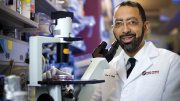Cancers, long defined primarily by where they arose (breast, lung, blood cells, brain) are proving to be as individual as faces: increasingly defined, scientists are discovering, by their unique genetic and molecular makeup. This ability to understand the genetics of individual cancers is changing the way the disease is treated. At Harvard and elsewhere, medical centers are investing in research tools to study cancer’s genetic features, and determining how best to apply the new knowledge in the clinic. This is part of a larger movement toward personalized or precision medicine, which aims to tailor disease prevention and treatment as much as possible to an individual patient.
That goal remains far off for most diseases, but rapid progress has been made against cancer, in which changes in genes are a defining feature. In some cases, inherited genes put people at higher risk. But more often, cancer arises from so-called somatic mutations: genetic changes and errors that occur within specific cells during a lifetime. These mutations allow cancer cells to proliferate, spread, and, in some cases, persist despite treatment.
Levi Garraway, associate professor of medicine at the Dana-Farber Cancer Institute (DFCI) and Broad Institute, says converging developments in the past few years have brought precision in cancer care closer than ever before. First, “The armamentarium of targeted agents in clinical trials is much larger,” he reports. The initial “targeted” cancer drug, Gleevec, was approved more than a decade ago; unlike chemotherapy drugs that kill cancer cells but can also be toxic to normal cells, Gleevec is designed to bind to and block an enzyme that’s produced only by cancer cells with a specific genetic mutation found in patients with chronic myelogenous leukemia (CML) and some other cancers. (For a physician’s account of the development and early use of Gleevec, see “Ken’s Story,” January-February 2007, page 36.) Researchers in academia and industry have since focused on discovering other important genetic mutations in cancer cells, developing agents to target those mutations, and testing those drugs.
Depending on the type of tumor, “a substantial proportion [of cases]—half or more—have a genetic alteration that a clinician might want to know about,” Garraway explains—either because a drug targeting that mutation is approved or in clinical trials, or because the mutation indicates that a certain treatment wouldn’t be effective in that patient. Researchers have found that the same mutations may be involved in widely different cancers, so a drug developed to target a mutation common in one type of cancer may also help a subset of patients with another type of cancer that shares that mutation. Gleevec, for instance, was developd for CML and then approved for a type of gastrointestinal tumor, and is being tested in patients with brain and soft-tissue cancers that show the same mutation.
Second, just as anticancer-drug development is accelerating, the cost of genetic sequencing is plummeting. Sequencing the entire genome of individual patients’ cancer is still not feasible, but tests can analyze a set of important or clinically relevant genetic mutations. Garraway says the technology to characterize cancers is advancing rapidly, but “it’s going to take a while to really understand how to use” that knowledge. The solution, he says, is more information: “We need to query each tumor and make sense of how that tumor was built.” George Demetri, professor of medicine at Harvard Medical School and senior vice president for experimental therapeutics at DFCI, believes that academia has an important role to play in this early-stage research to find promising targets; the pharmaceutical industry, he says, is “looking more to academia to make discoveries that we can work on together.”
Ideally, it would be possible to characterize each patient’s tumor and prescribe an individually tailored cocktail of targeted medicines aimed at the malignancy, plus new drugs designed to stimulate the immune system against the disease. But Demetri admits that this goal is challenging. Cancers are genetically unstable; they may have a chaotic mix of changes in DNA, RNA, and other molecules that complicate the task of researchers trying to determine what is truly crucial to target. And not all alterations can be easily targeted with a drug. Even obtaining material to profile can be a challenge: cells in one part of a tumor may be genetically distinct from cells in another part. (Demetri’s group recently announced a method to characterize specific mutations in one type of tumor using a blood test, rather than an invasive biopsy.) Finally, targeted cancer therapies are also expensive, so some scientists have questioned the feasibility of developing cocktails of drugs as part of routine medical care.
Nevertheless, academic medical centers are building resources to facilitate precision medicine. Beth Israel Deaconess Medical Center is developing a national curriculum to train pathology residents in genomic techniques, to better prepare them to use new molecular-based tests. DFCI and Brigham and Women’s Hospital are amassing one of the world’s largest databases of cancer genetic abnormalities by surveying large numbers of patient tumors for 471 mutations in 41 different genes. The Translational Research Laboratory at Massachusetts General Hospital focuses on applying such research directly to clinical care: it now offers a molecular “fingerprinting” service to patients with certain cancers for which targeted drugs are available. It’s not yet clear how these new technologies will be incorporated into routine care, but many experts are hopeful that they will lead to new ways of defining and attacking a disease that worldwide kills more than 7 million people a year.









